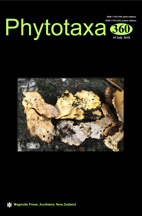Abstract
We studied leaf anatomy, mitotic chromosomes and pollen grains of nine species of Euphorbia (E. chamaesyce, E. granulata, E. indica, E. humifusa, E. maculata, E. petiolata, E. prostrata, E. serpens and E. nutans) out of the 15 species of Euphorbia subg. Chamaesyce present in Iran. We compared our results with two species of subg. Esula sections Tythymalus and Helioscopia (E. peplus and E. helioscopia). Our anatomical survey identified the Kranz bundle sheath as a distinct anatomical character for subgenus Chamaesyce sect. Anisophyllum, differentiating this from E. petiolata of subg. Chamaesyce sect. Cheirolepidium. Based on type of abaxial epidermis cell walls, species were classified into three groups including species with zigzagged, sinuous and intermediate (zigzagged-sinuous) walls. Chromosome numbers for four species were reported for the first time from Iran, and 2n=32 is the first report for E. indica. Three shapes of pollen grains were determined: oblate spheroidal, prolate spheroidal and subprolate. A tectate perforate exine ornamentation was detected in almost all of the
species.

